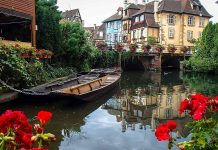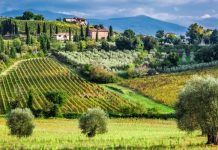
Évora: Roman Ruins and the Bone Chapel of Timeless Charm
Nestled in the heart of Portugal’s Alentejo region, Évora is a city where history whispers through ancient streets, Roman ruins stand proudly, and a hauntingly beautiful chapel reminds visitors of life’s fleeting nature. A UNESCO World Heritage Site since 1986, Évora seamlessly blends Roman, Moorish, and medieval influences, offering travelers a journey through time. From the well-preserved Temple of Diana to the eerie yet captivating Capela dos Ossos (Bone Chapel), Évora’s timeless charm leaves an indelible mark on all who visit.
A Walk Through Roman Évora
Évora’s history dates back over two millennia, with its golden age unfolding under Roman rule. The city, then known as Ebora Liberalitas Julia, was an important administrative and commercial hub. Today, the most striking remnant of this era is the Temple of Diana, a first-century AD Roman temple that dominates the city’s skyline.
The Temple of Diana
Perched atop Évora’s highest point, this Corinthian-columned temple is one of the best-preserved Roman structures in Portugal. Though traditionally linked to the goddess Diana, historians now believe it was dedicated to Emperor Augustus. The temple’s 14 granite columns, standing tall against the Alentejo sky, create a mesmerizing sight, especially at sunset when the warm light bathes the ancient stones in gold.
Roman Baths and the Imperial Legacy
Beneath the city hall lies another Roman treasure—the Roman Baths of Évora. Discovered in 1987, these ruins include a well-preserved laconicum (a circular sweating room) and a frigidarium (cold bath). The intricate heating system (hypocaust) showcases Roman engineering brilliance, proving Évora’s significance in the empire.
Medieval Mystique: Évora’s Gothic and Moorish Heritage
After the fall of Rome, Évora flourished under Moorish rule before being reclaimed by Christian forces in 1165. The city’s medieval character is best seen in:
Sé de Évora (Évora Cathedral)
A masterpiece of Gothic and Romanesque architecture, the cathedral’s twin towers and rose window dominate the skyline. Inside, the Museum of Sacred Art displays priceless religious artifacts, while the rooftop offers panoramic views of the Alentejo plains.
The University of Évora
Founded in 1559 by the Jesuits, this Renaissance-era university once rivaled Coimbra in prestige. Its cloisters, azulejo-tiled halls, and the Mannerist-style Church of the Holy Spirit reflect Portugal’s intellectual and artistic golden age.
The Bone Chapel: A Meditation on Mortality
No visit to Évora is complete without confronting the Capela dos Ossos (Chapel of Bones), a 16th-century Franciscan chapel lined with the skeletal remains of over 5,000 monks.
The Story Behind the Bones
Built in the 16th century, the chapel was intended as a memento mori—a reminder of life’s transience. Its entrance bears the chilling inscription: “We bones that are here, for yours we wait.” Inside, skulls and femurs adorn the walls in intricate patterns, while two desiccated corpses hang from chains—a stark meditation on death.
Why Visit the Bone Chapel?
Beyond its macabre allure, the chapel invites reflection on human existence. The adjoining Igreja de São Francisco (Church of St. Francis) contrasts with its bright Baroque altars, creating a fascinating duality between life and death.
Beyond the Monuments: Évora’s Living Culture
Évora isn’t just about ruins and bones—it’s a vibrant city where tradition thrives.
Gastronomy: A Taste of Alentejo
- Bacalhau à Brás (shredded cod with eggs and potatoes)
- Migas (bread-based dish with pork)
- Queijo de Évora (local sheep’s milk cheese)
- Alentejo wines, particularly full-bodied reds from nearby vineyards
Festivals & Craftsmanship
- Feira de São João (June fair with folk music and crafts)
- Handmade cork products (Alentejo produces half the world’s cork)
Conclusion: Évora’s Eternal Allure
Évora is more than a museum city—it’s a living tapestry of Roman grandeur, medieval spirituality, and haunting beauty. Whether you stand before Diana’s Temple, wander the cathedral’s cloisters, or ponder mortality in the Bone Chapel, Évora captivates with its timeless charm. A visit here isn’t just a step back in time—it’s an encounter with the soul of Portugal.
Plan Your Visit:
- Best time to go: Spring (March-May) or Autumn (September-October)
- Must-see: Temple of Diana, Bone Chapel, Évora Cathedral
- Don’t miss: Trying pão com chouriço (chorizo bread) at a local bakery





















